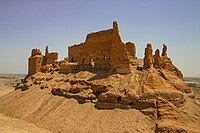Malik ibn Tawk
Malik ibn Tawk ibn Malik ibn 'Attab at-Taghlibi مالك بن طوق بن مالك بن عتاب التغليبي | |
|---|---|
| Governor of Damascus and Jordan | |
| In office 847 – 850 | |
| Monarch | Al-Mutawakkil |
| Preceded by | Rija ibn Ayyub al-Hadari (841–847) |
| Succeeded by | al-Mu'ayyad |
| Governor of Mosul | |
| In office 829 – 831 | |
| Monarch | al-Mamun |
| Preceded by | Muhammed ibn al-Sayyid ibn Anas (827–828) |
| Succeeded by | Mansur ibn Bassam (c.834–838) |
| Personal details | |
| Died | 873 |
| Parent | Tawk ibn Malik ibn Attab at-Taghlibi |
Malik ibn Tawk ibn Malik ibn 'Attab at-Taghlibi (Arabic: مالك بن طوق التغلبي) (died 873) was an Arab Abbasid official during the reigns of caliphs al-Wathiq (r. 842–847) and al-Mutawakkil (r. 847–861). He is best known as the founder of the fortress town of al-Rahba on the western banks of the Euphrates, part of the present-day Syrian town of Mayadin.
Biography
Malik ibn Tawk belonged to the Arab tribe of Banu Taghlib and traced his lineage to the 6th-century Taghlibi poet warrior Amr ibn Kulthum.[1] His father, Tawk ibn Malik, served as governor of Diyar Rabi'a, the district of the eastern Jazira (Upper Mesopotamia) under the Abbasid caliph al-Ma'mun (r. 813–833).[2] He also served as a general under al-Ma'mun's predecessor, Caliph Harun al-Rashid (r. 786–809),[1] Some Muslim sources have often incorrectly made the son Malik ibn Tawk to have been the one in the service of Harun and al-Ma'mun instead of his father.[2] Malik ibn Tawk served under the caliphs al-Wathiq (r. 842–847) and al-Mutawakkil (r. 847–861) as the governor of Jund al-Urdunn (military district of Jordan) and Jund Dimashq (military district of Damascus).[2]
Sometime in the latter half of the 9th century, Malik convinced his kinsman, Sahl ibn Bishr, a great-grandson of the 7th-century Taghlibi poet al-Akhtal, to convert to islam from Christianity along with the other direct descendants of al-Akhtal.[2] Malik founded the Euphrates Valley fortress of al-Rahba and became its lord. The fortress town was since alternatively known as "Rahbat Malik ibn Tawk".[1] He died in 873.[1] His son Ahmad succeeded him as the lord of al-Rahba, but was forced out of the town in 883 by the lord of al-Anbar, Muhammad ibn Abi'l-Saj.[3]

The al-Rahabi clan of the Euphrates basin, claims descent from Malik ibn Tawk.
References
- ^ a b c d Kay, Henry C. (October 1886). "Notes on the History of the Banu 'Okayl". Journal of the Royal Asiatic Society of Great Britain and Ireland. 18 (4): 504. doi:10.1017/S0035869X00161490.
- ^ a b c d Lecker, M. (2000). "Taghlib b. Wa'il". In Bearman, P. J.; Bianquis, Th.; Bosworth, C. E.; van Donzel, E. & Heinrichs, W. P. (eds.). The Encyclopaedia of Islam, Second Edition. Volume X: T–U. Leiden: E. J. Brill. pp. 92–93. ISBN 978-90-04-11211-7.
- ^ Bianquis, Thierry (1995). "Al-Rahba". In Bosworth, C. E.; van Donzel, E.; Heinrichs, W. P. & Lecomte, G. (eds.). The Encyclopaedia of Islam, Second Edition. Volume VIII: Ned–Sam. Leiden: E. J. Brill. pp. 393–394. ISBN 978-90-04-09834-3.
